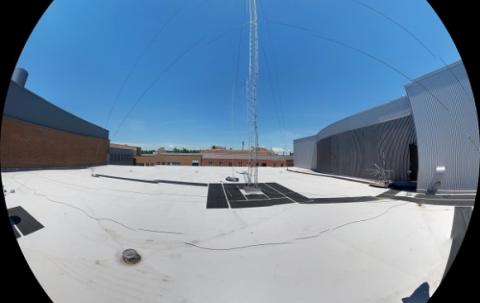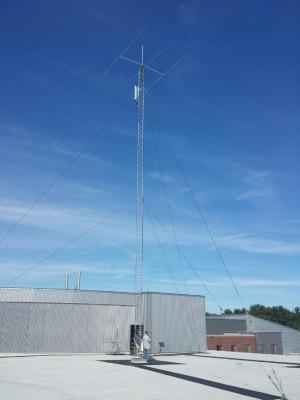Sector antennas, improved spectrum analysis elevate data rates significantly.
Author: Stewart Schley

The second phase of the trial that uses TVWS spectrum to provide over-the-air Internet access from the University of New Hampshire campus to remote libraries produced significantly improved performance, with top downstream data rates nearing 10 Mbps, and upstream rates nearing 5 Mbps.
The UNH Broadband Center of Excellence connected three libraries and selected campus locations to base stations located at UNH’s Stoke Hall and Kingsbury Hall buildings. The networking trial used fallow airwaves within spectrum reserved for television broadcasting – the so-called “TV White Spaces.”
Rouzbeh Yassini, the Executive Director of UNH BCoE, said the results “demonstrate real potential for TVWS networks to make broadband connectivity available in rural and unserved areas of the country.”
UNH BCoE worked with Carlson Wireless Technologies of Arcata, Calif., in Phase 2 of a TVWS trial that took place in 2014. In Phase 1, downstream data rates languished in the sub-2 Mbps range, with occasional to frequent signal interruptions and difficulties establishing connectivity at some locations. But changes involving antennas, network configuration, modulation, software enhancements and other approaches triggered significant improvements.
Read about the original UNH BCoE TVWS trial in this report
But changes involving antennas, network configuration, modulation and other approaches have triggered significant improvements.

For example, the updated network implementation achieved a downstream rate of 5.66 Mbps and an upstream rate of 1.67 Mbps over the link connecting the directional antenna mounted on the Kingsbury Hall rooftop (see photo) to the Barrington, N.H. Public Library roughly 8 miles away. Within the more concentrated UNH campus footprint, downstream data rates approached 10 Mbps.
Also, a separate link was successful in establishing and maintaining a symmetrical 1 Mbps signal between the Stoke Hall antenna site and the Lee, N.H. library, where connectivity previously could not be achieved.
Here are some of the modifications the UNH BCoE team implemented in conjunction with Carlson Wireless to help lift the performance:
- Improved signal-to-noise: The base station RF radio electronics were connected to the antenna with a short RF cable pigtail, with the radio connected to its base station inside a control room by CAT-5 cable. (In the previous iteration, all base station electronics were mounted in a single enclosure that was connected to the antenna using 100 feet of RF cable, with its inherent losses.)
- Higher transmitting power: The use of a sector antenna with a coverage area of roughly 120 degrees provided additional gain to designated client locations and minimized interference from other areas. For example changing from an omnidirectional antenna to a sector antenna pointed from Stoke Hall to the Durham, N.H., Public Library led to a dramatic improvement in data rates, to 4.9/1.5 Mbps (downstream/upstream) from 0.81/0.15 Mbps.
- Higher-quality receivers: The use of client antennas with improved gain characteristics over the original antennas has contributed to improved signal performance.
- Network planning: The UNH BCoE team implemented more detailed review of the available spectrum characteristics in advance, coupled with ongoing signal monitoring post-installation. Additionally, proprietary tools provided by Carlson allowed signal measurement at the client sites and fine-tuning of antenna orientation.
- Advanced field tools: The use of an accurate compass application running on a smartphone provided more precise directional data for antenna orientation optimization. In addition a spectrum analyzer was used to take RF signal power measurements.
The UNH BCoE TVWS deployment used channels 22 and 23 within the television white space spectrum. Testing by UNH BCoE found strong propagation characteristics, along with low noise and ingress in these channels. (TVWS implementations rely on FCC-approved databases to indicate available channels by TV market).
